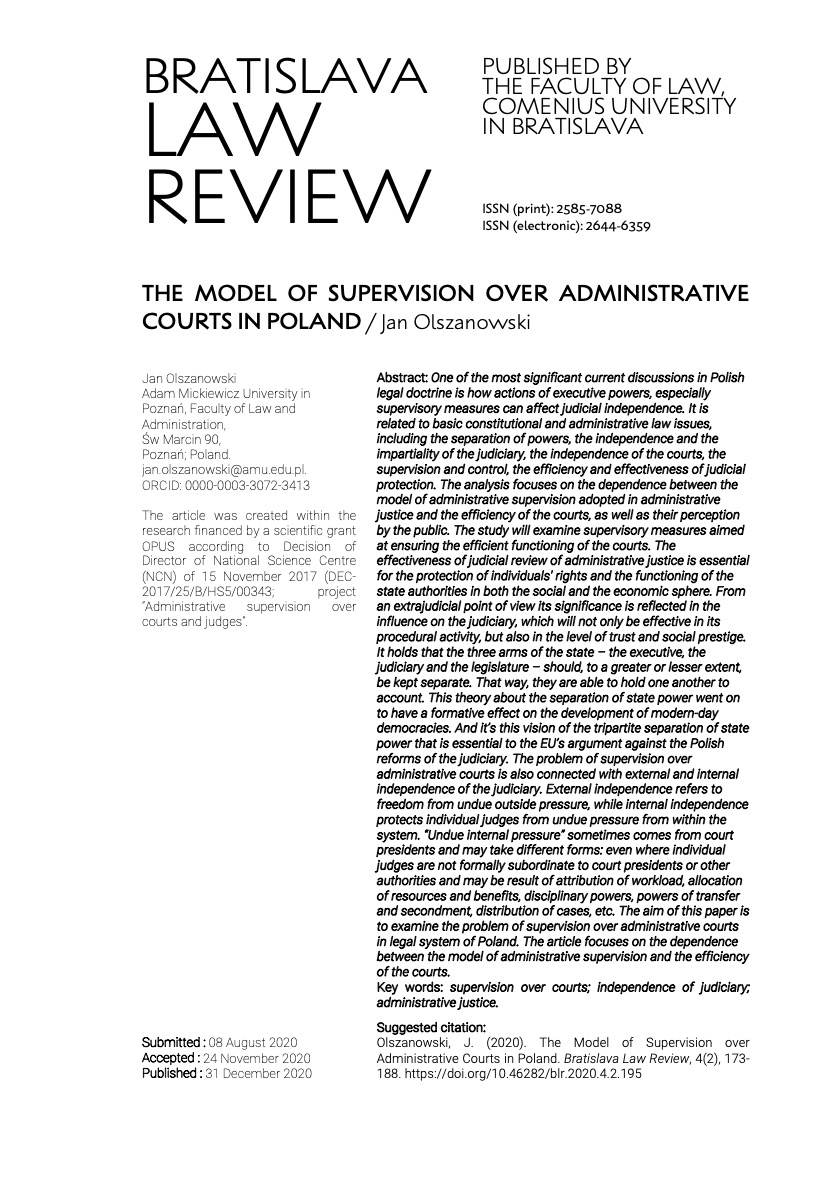The Model of Supervision over Administrative Courts in Poland
DOI:
https://doi.org/10.46282/blr.2020.4.2.195Keywords:
supervision over courts, independence of judiciary, administrative justiceAbstract
One of the most significant current discussions in Polish legal doctrine is how actions of executive powers, especially supervisory measures can affect judicial independence. It is related to basic constitutional and administrative law issues, including the separation of powers, the independence and the impartiality of the judiciary, the independence of the courts, the supervision and control, the efficiency and effectiveness of judicial protection. The analysis focuses on the dependence between the model of administrative supervision adopted in administrative justice and the efficiency of the courts, as well as their perception by the public. The study will examine supervisory measures aimed at ensuring the efficient functioning of the courts. The effectiveness of judicial review of administrative justice is essential for the protection of individuals' rights and the functioning of the state authorities in both the social and the economic sphere. From an extrajudicial point of view its significance is reflected in the influence on the judiciary, which will not only be effective in its procedural activity, but also in the level of trust and social prestige. It holds that the three arms of the state – the executive, the judiciary and the legislature – should, to a greater or lesser extent, be kept separate. That way, they are able to hold one another to account. This theory about the separation of state power went on to have a formative effect on the development of modern-day democracies. And it’s this vision of the tripartite separation of state power that is essential to the EU’s argument against the Polish reforms of the judiciary. The problem of supervision over administrative courts is also connected with external and internal independence of the judiciary. External independence refers to freedom from undue outside pressure, while internal independence protects individual judges from undue pressure from within the system. “Undue internal pressure” sometimes comes from court presidents and may take different forms: even where individual judges are not formally subordinate to court presidents or other authorities and may be result of attribution of workload, allocation of resources and benefits, disciplinary powers, powers of transfer and secondment, distribution of cases, etc. The aim of this paper is to examine the problem of supervision over administrative courts in legal system of Poland. The article focuses on the dependence between the model of administrative supervision and the efficiency of the courts.
References
Charter on the Fundamental Rights of the European Union.
Convention on the Protection of Human Rights and Fundamental Freedoms.
International Pact on Civil and Political Rights.
Poland, Konstytucja Rzeczypospolitej Polskiej [Constitution], Apr. 2, 1997.
Poland, Act on the System of Common Courts, Journal of Laws (2001).
Poland, Act on the System of Administrative Courts, Journal of Laws (2002).
Poland, Act on the Proceedings before Administrative Courts, Journal of Laws (2002).
Poland, Act on the Supreme Court, Journal of Laws (2017).
Poland, Act amending the Act on the National Council of the Judiciary and some other acts, Journal of Laws (2017).
Poland, Constitutional Tribunal, K 11/93, OTK No. 2/1993 (9 November 1993).
Poland, Constitutional Tribunal, K 3/98, OTK ZU No. 4/1998 (24 June 1998).
Poland, Constitutional Tribunal, P 16/03, OTK No. 4/A/2004 (27 April 2004).
Poland, Constitutional Tribunal, P 15/05, OTK No. 11/A/2006 (12 December 2006).
Poland, Constitutional Tribunal, SK 7/06, OTK-A No. 9/2007/9 (24 October 2007).
Poland, Constitutional Tribunal, K 45/07, OTK-A 2009/1/3 (15 January 2009).
Poland, Constitutional Tribunal, Kp 3/09, OTK ZU No. 9/A/2009 (28 October 2009).
Poland, Constitutional Tribunal, K 23/09, OTK ZU No. 2/A/2011 (3 March 2011).
Poland, Constitutional Tribunal, P 49/13, OTK ZU No. 7/A/2014 (29 July 2014).
Poland, Constitutional Tribunal, K 34/15 (3 December 2015).
COM(2017) 835, 2017/0360 (APP), Reasoned proposal in accordance with the article 7 (1) of the Treaty on European Union regarding the rule of Law in Poland: Proposal for a COUNCIL DECISION on the determination of a clear risk of a serious breach by the Republic of Poland of the rule of law (BELGIUM, 2017).
Report of the Venice Commission on the independence of the judicial system, Part I: the independence of judges, CDL-AD(2010)004, Study No. 494 / 2008 (2010).Banaszak, B. (2014). Konstytucyjne i ustawowe uwarunkowania niezawisłości sędziowskiej. Iustitia., 1(15).
Banaszak, B. (2017). Prawo konstytucyjne. (8th ed.). Warsaw: C.H. Beck.
Biernat, S. (2018). How to Assess the Independence of Member State Courts? Retrieved from https://doi.org/10.17176/20180730-100627-0
Bobek, M. (2010). The Administration of Courts in the Czech Republic – in Search of a Constitutional Balance. European Public Law., 16(2).
Bojarski, L., & Wejman, F. (Eds.). (2017). Legal think tanks and governments capacity building (Report). Warsaw: Inpris.
Celej, M. (2007). Jaki powinien być nadzór nad sądami i kto ma go sprawować. Retrieved from https://www.rp.pl/artykul/70144-Jaki-powinien-byc-nadzor-nad-sadami-i-kto-ma-go-sprawowac.html.
Correia, S. (1993a). Separation of powers and judicial review of administrative decisions in Portugal. In C. Zoethout, G. van der Tang, & P. Akkermans (Eds.), Control in Constitutional Law. Dordrecht/Boston/London: Martinus Nijhoff Publishers.
Correia, S. (1993b). Separation of powers and judicial review of administrative decisions in Portugal. Revista Da Faculdade de Direito Da Universidade de Lisboa., 34.
Gudowski, J. (1994). Urząd sędziego w prawie o ustroju sądów powszechnych. Przegląd Sądowy., (11–12).
Gudowski, J. (2015). Sąd Najwyższy. Pozycja ustrojowa, funkcje i zadania (spojrzenie sędziego cywilisty). Przegląd Sądowy., (11–12).
Jansen, A. M. L. (2005). Towards an Adjustment of the Trias Politica: the Administrative Courts as (Procedural) Lawmaker; a Study of the Influence of the European Human Rights Convention and the Case Law by the European Court of Human Rights on the Trias Politica, in particular t. In F. Stroink & E. Van der Linden (Eds.), Judicial Lawmaking and Administrative Law. (1st ed., pp. 37–55). Intersentia.
Kiener, R. (2001). Richterliche Unabhängigkeit. Verfassungsrechtliche Anforderungen an Richter und Gerichte. Bern: Stämpfli Verlag AG.
Kmieciak, Z. (2012). Instancyjność postępowania administracyjnego w świetle Konstytucji RP. Państwo i Prawo., (5), 3–17.
Kmieciak, Z. (2013). The Efficiency of Administrative Courts (in the Light of European and Polish Experiences). Comparative Law Review, 15(15), 135–150. Retrieved from https://doi.org/10.12775/CLR.2013.008
Koncewicz, T. T. (2017). Living under the unconstitutional capture and hoping for the constitutional recapture. Retrieved from https://doi.org/10.17176/20170103-141016.
Kosař, D. (2017). Politics of Judicial Independence and Judicial Accountability in Czechia: Bargaining in the Shadow of the Law between Court Presidents and the Ministry of Justice. European Constitutional Law Review, 13(1), 96–123. Retrieved from https://doi.org/10.1017/S1574019616000419
Kuczyński, T., & Masternak-Kubiak, M. (2009). Prawo o ustroju sądów administracyjnych. Komentarz. Warsaw: Wolters Kluwer Polska.
Łazarska, A. (2015). Pozycja ustrojowa sędziego. In R. Piotrowski (Ed.), Pozycja ustrojowa sędziego. (p. 323). Warsaw: Wolters Kluwer Polska.
Lienhard, A. (2009a). Oberaufsicht und Justizmanagement. Justice - Justiz - Giustizia., (1), 1 – 21.
Lienhard, A. (2009b). Supervisory Control and Court Management. International Journal for Court Administration, 2(1), 30–45. Retrieved from https://doi.org/10.18352/ijca.110
Lienhard, A., & Kettiger, D. (2017). Between Management and the Rule of Law: on the move towards a management model for the judiciary - Results from the project “Basic research into Court Management in Switzerland”. International Journal for Court Administration, 8(2), 7–19. Retrieved from https://doi.org/10.18352/ijca.219
Malicki, A. (2019). Niezawisłość sędziego a niezależność adwokata w procesie. Warsaw: Wydawnictwo C. H. Beck.
Mikuli, P. (2014). Current Debates on the Supervision over the Administrative Activity of the Common Courts. European Public Law., 20(3), 521–537.
Mikuli, P. (2017). Tug of war between the judiciary and the Minister of Justice : on Court Administration in Poland. In P. Mikuli (Ed.), Current challenges in Court Administration. Hague: Eleven international publishing. Retrieved from https://doi.org/10.13140/RG.2.2.31065.52329
Oleszko, A. (1988). Zwierzchni nadzór administracyjny a niezawisłość sędziowska w świetlre prawa o ustroju sądów powszechnych. Nowe Prawo., 10–12(10–12).
Piotrowski, R. (2018). Sędziowie i granice władzy demokratycznej w świetle Konstytucji RP. Ruch Prawniczy, Ekonomiczny i Socjologiczny, 80(1), 215–229. Retrieved from https://doi.org/10.14746/rpeis.2018.80.1.17
Popova, M. (2012). Politicized Justice in Emerging Democracies. Cambridge: Cambridge University Press. Retrieved from https://doi.org/10.1017/CBO9781139055345
Shetreet, S. (1984). Judicial Independence and Accountability in Israel. The International and Comparative Law Quarterly., 33(4), 979–1012.
Simonis, M. (2019). Effective Court Administration and Professionalism of Judges as Necessary Factors Safeguarding the Mother of Justice – The Right to a Fair Trial. International Journal for Court Administration, 10(1), 47–58. Retrieved from https://doi.org/10.18352/ijca.294
Skoczylas, A. (2004). Działalność uchwałodawcza Naczelnego Sądu Administracyjnego. Warsaw: C. H. Beck.
Skoczylas, A., & Swora, M. (2007). Administrative Judiciary in Poland in Search for Fairness and Efficiency - an Overview. Transylvanian Review of Administrative Sciences., 3(19), 116–125.
Sobczak, J. (2015). Niezawisłość sędziowska i niezależność sądów. Problem ważny i ciągle aktualny. Gdańskie Studia Prawnicze – Przegląd Orzecznictwa., (4), 79–115.
Starski, P. (2016). The Power of the Rule of Law: The Polish Constitutional Tribunal’s Forceful Reaction. Retrieved from https://doi.org/0.17176/20160317-165259
Tremmel, J. (2014). An extended separation of powers model as the theoretical basis for the representation of future generations forthcoming. In D. Birnbacher & M. Thorseth (Eds.), Roads to Sustainability. London.
Turłukowski, J. (2016). Administrative Justice in Poland. BRICS Law Journal, 3(2), 124–152. Retrieved from https://doi.org/10.21684/2412-2343-2016-3-2-124-152
Uitz, R. (2009). Rozważania na temat postaw niezawisłości sędziowskiej oraz dalsze uwagi o statusie konstytucyjnym prokuratorów. In T. Wardyński & M. Niziołek (Eds.), Niezależność sądownictwa i zawodów prawniczych jako fundamenty państwa prawa. Wyzwania współczesności. (1st ed.). Warsaw: LexisNexis.
van Dijk, F. (2014). Improved Performance of The Netherlands Judiciary: Assessment of the Gains for Society. International Journal for Court Administration., 6(1).
Warszawski Oddział ‘Iustitii’ w sprawie dobrych praktyk nadzorczych. (2013). Retrieved from http://iustitia.pl/index.php/uchwaly/717-warszawski-oddzial-iustitii-w-sprawie-dobrych-praktyk-nadzorczych.
Żackiewicz- Zborska, K. (2008). Nadzór nad sądami dla prezesa Sądu Najwyższego. Retrieved from https://www.gazetaprawna.pl/amp/6390,nadzor-nad-sadami-dla-prezesa-sadu-najwyzszego.html.
Zawiślak, K., Sawko, E., & Bujak, I. (2009). Sędziów uwag kilka w związku z projektem zmian ustawy – Prawo o ustroju sądów powszechnych (FORUM). Monitor Prawniczy, (15).
Żurek, W., & Mazur, D. (2017). Wymiar sprawiedliwości w Polsce u progu 2017 r. – Wyzwania i zagrożenia. Ruch Prawniczy, Ekonomiczny i Socjologiczny., (1), 25–36.

Downloads
Published
Issue
Section
Categories
License
Copyright (c) 2020 Bratislava Law Review

This work is licensed under a Creative Commons Attribution-NonCommercial-NoDerivatives 4.0 International License.
The Author(s) transfers copyright to the Article to the Publisher of the Journal by the Licence Agreement.
The Author(s) retains rights specified in the Licence Agreement.
The readers may read, download, copy, distribute, print, search, or link to the full texts of all of the Article of the Journal and use them for any other lawful purpose under specified Creative Commons Licence (CC BY-NC-ND 4.0).











